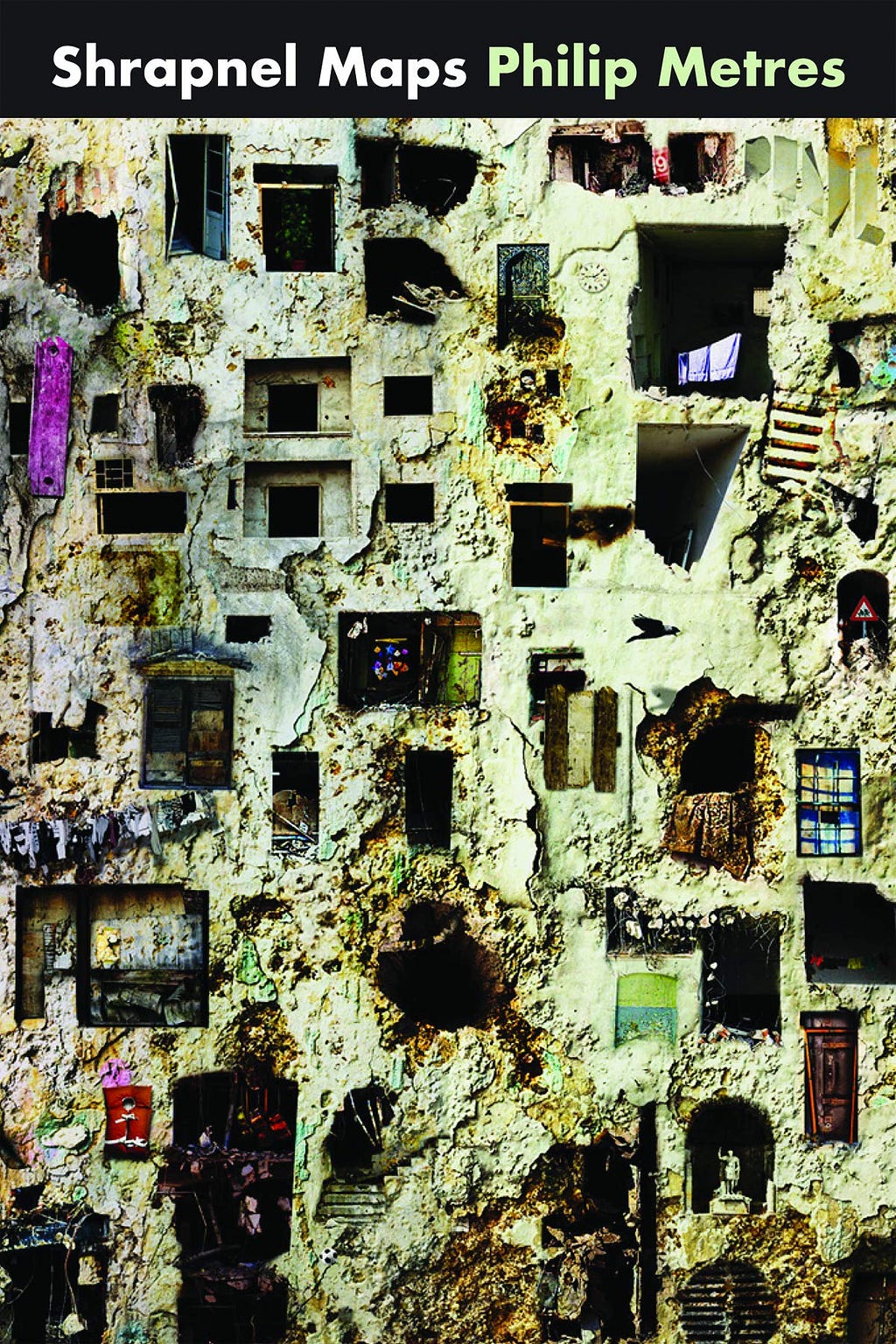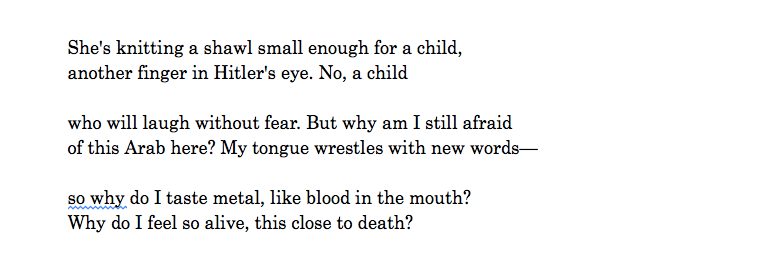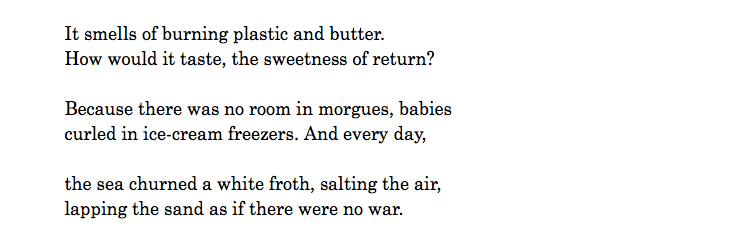Philip Metres’ poem, “Future Anterior,” is structured as a series of questions (and returns) answered by multiple voices. Since this form felt close to the heart of Shrapnel Maps, I borrowed it for this essay.

What is shrapnel?
Shrapnel as a noun refers to fragments of a bomb, shell, or other object thrown out by an explosion; debris. Shrapnel is here from the start, in Metres’ epigraphs, which end with Mahmoud Darwish’s words: “my language is shrapnel.”
What is shrapnel again?
In “Act One: Our House Is Now Another House,” the sections are titled by the name of the first-person narrator. The house switches hands and owners. Metres’ poems alternate between Jewish and Palestinian voices. Here, Noah speaks:

Shrapnel is the taste of fear in a mouth, it’s hard metal exterior oxidizing. Shrapnel was named after General Henry Shrapnel (1761–1842), the British soldier who invented the shell, though the sense of splintered bomb fragments, and the need for this term, originated during the First World War. Was shrapnel the accident — or the intended, rippling harm?
What is a map?
Map as a noun refers to a diagrammatic representation of an area of land or sea showing physical features, cities, roads, etc. Metres offers a definition of map in “Future Anterior”:

His definition relies on the French future anterior tense, and its construction of auxiliary verb + past participle. It is the tense of potentiality which imagines “what will have been” before an event actually transpires. The map, itself, is a text of possibility and division. Think of chaos theory where all potentials are possible and not yet decided. In a sense, the future anterior is the time of not yet as well as compossibility.
What is a map again?
A map is the past’s presence, the bounded future. The danger of the map lies in its conflation of essentialisms and nations. A map is a record, a document, a text. In “Three Books (A Simultaneity)”:

A map is official, simple. No wail is legible on a map.
What is return?
The Arabic word for return is awda. For Palestianians, awda is directional: a looking back that includes the act of returning to the homeland they fled in 1948.
Section VIII, “Returning to Jaffa,” is dedicated to Nahida Halaby Gordon, whose family fled to the US 1948. In the afterword, Metres notes that the municipal records from the British Mandate are missing. Documents are incorporated into the poem, rendered as text.
“3” is a postcard titled “Tel Aviv (Explore Old Jaffa).” These juxtapostions create a dialogue between images, idylls, and grief. “5” is “Instruction to the Arab Population,” a Hanagah flyer that Gordon found in her father’s papers after his death. The flyer was written in English, directing British forces on how to “handle” Palestinians.
In the final part of this section, Metres speaks from Nahida Halaby Gordon’s inability to forget. He enacts a continuous return as an “Ode to the Orange of Jaffa”:

The return is rooted in the senses and smells, the memory of the orange, the use of the ode as a reconvening.
What is return again?
Section IX consists of a long poem, “When It Rains In Gaza,” organized by couplets. The sixth section of “When It Rains In Gaza” is titled “Al-Awda Means Return.” In 2014, Israel bombed the al-Awda ice-cream factory. The poem circles the question of whether the factory held medicine or terrorism. Narrated from inside Gaza, there is the question of why the factory was bombed. Return’s olfactory component is centered:

In the essay, “Of Seeing, the Unseen, and the Unseeable: Technology, Poetry, and ‘When It Rains in Gaza’.” Metres says he wanted “to hold a space” for the grief and voice of Iyad al-Tibani, the factory’s owner. The poems of different voices recreate Gaza by reconstituting the grief of individual loss. “Whatever Gaza I think I know, it is a Gaza of the mind,” Metres writes, “Not Gaza.” He credits Deema Shehabi’s poetry for giving him the Gaza he knows.
What is family? What is longing?
Family as a noun refers to a group consisting of parents and children living together in a household; all the descendants of a common ancestor. As in “the house has been owned by the same family for 300 years.” Family is how you enter the world and how you leave it. Maybe we all want to be buried near our kinfolk, to rot in a soil that does not reject us, a soil that claims us for its dust.
The connection between longing and belonging feels imminent. It is difficult to read these poems without thinking about the larger project of the nation-state and its imagined communities forged in order to create governable citizens from disparate linguistic, social, and cultural groups. Longing is the act of looking back into the possible future. And belonging is the way longing is mobilized into political claims, the result of identities constructed by exclusivity, competitive, tied to the needs of nation-states, defined in opposition to each other.
What is family again?
“Family” exposes the tensions between narratives of belonging. This land belongs to me and I belong to it. To be displaced from a land is deeply damaging to the social self. The stronger the identification between land and identity, the greater the risk of violence in displacement. Metres repeats his position as various sides argue over the land of Israel — “I shrink again.” The poet, a mapped self, shrinks and watches the construction:

What is a margin?
Metres starts several poems in the right-hand margin as if to separate them by perspective, as if to formally enact the taking of “sides” on the field of the page. In “Marginalia With Uprooted Olive,” he begins:

The outsider, the displaced person, is not a description of a human so much as it is a description of how social forces (and the narrowed eyes of identity) instrumentalize a human, transforming them into an other; the most brutal objectification precisely because it is empty, it is a commentary on the text rather than the text itself. The description of Palestinians as those whose identity only exists in response to Jewishness is marginal.
What is a citizen?
The citizen is someone who exists on a map. Refugees and immigrants are familiar with the role of documents in the denial of their claims to existence. Undocumented humans know the intimate terror statelessness, or existing between official versions, to lack a map’s context.
In “Bride of Palestine: to be read by four people simultaneously,” Metres borrows the form of Greek tragedy to reveal how refugees are created by threats of violence, by laws designed to re/place them. What does it mean to exist outside the visual realm of protection? The Nuremberg trials helped create a legal narrative and foundation for human rights that applied to stateless refugees, particularly Jewish persons. We in the US have forgotten what we never learned, namely, that the stateless are the most vulnerable human beings on the planet. The passported human is powerful in ways that we can’t unpack without looking in the mirror. “What countries could we see, and what countries could we make, if we erased the erasures?” Metres asks in “Dispatch from the Land of Erasures (1),” an essay from 2018.
What is a homeland?
“The map is not the answer…And the birth certificate is no longer the same. No one has to face this question as you have, from this moment till you die, or repent, or become a traitor.”
- Mahmoud Darwish
All notions of fatherlands and motherlands rely on the notion of a state as a family. A family is worth dying for. A family is worth defending. A homeland is the site of national self-defense. In Section IV. “Theater of Operations,” the poems alternate speakers as as a suicide bombing is planned and executed. It is harrowing and heartbreaking. It is the poetry of absolute hopelessness.
What is return, again? Is it a right? It is a form of flight?
In 1950, Israel passed the “Law of Return,” granting all Jews the right to return to a land they had never known except in stories and religious texts. The rise of violent, horrific genocidal anti-Semitism put Israel on the map for many Jews, trapped in countries determined to murder and erase them completely.
But Jews did not return to Israel or to the land of their descendants. Language is interesting here: a Jew ascends to Israel, as in aleh, meaning to ascend or rise. To leave Israel is to descend from it, as in yerida.
Primo Levi spent decades arguing for the “right of Jews to remain dispersed in their diaspora,” to live in the diaspora of their choice, which might not align with the diaspora of their birth. For Levi, citizenship was secular and not rooted in ethnic identity so much as political affiliation. But how can we escape the closeness between religion and politics now? Does the relationship between religious eschatology and identity consecrate violence, make war, itself, sacred? What is a rhetorical question in this context?
The importance of naming is bound in our notions of the sacred, of blasphemy, of inheritance. The unnamed son is erased from the family’s title deeds. The unnamed people are erased from the record of history. In Israel, Palestinians who live there are not called Palestinians. They are called the Arab sector or the Arab minority.
In “Palestinae [Rudimentum Novit [i]orum] [1475]” erases by reference to religion:

And then, what follows in this logic:

But what is a bracket?
The noun bracket refers to a category of people or things that are similar or fall between specified limits as well the pair of marks [ ] used to enclose words or figures so as to separate them from the context. To bracket, as a verb, is place (one or more people or things) in the same category or group. The tension between the act of bracketing and the creation of the bracketed noun, or category, recurs at both the level of form and meaning in this collection.
Brackets set apart in silence. In numerous poems, Metres titles the page with empty brackets while using the poem’s first line as a ersatz-title in the table of contents. This tiny detail may be a poetic convention, and yet the empty, uninhabited brackets feel heavier than in other contexts.
Among the bracket poems, “In the sudden chill, dogwood leaves blush,” where alienation is carried by an external object, namely a t-shirt with two flags and two languages saying peace and hello:

In “My neighbor’s handshake is firm”, the empty brackets serve a similar formal function, designating an interior absence.

There are inhabited brackets as well. “[The Daily Contortions]” is hard to read, hard for any parents to observe the hurt that exclusion roots in their children, and when this exclusion is tied to race or religion or ethnicity, those hurts are internalized as lessons about life. About the limits of friendship. About the burdens we ask children to carry in the name of their fathers. History is bigger than our children, big as we make it, and Metres’ intimate rendering of a father in “the daily contortions” is visceral:

It is as if the potential for pain, for something lodged inside the skin, kins the shrapnel to the splinter. It’s only a small thing, the smallest ache. What is heritage?
Forget heritage. What is time?
This book makes its own time. By combining and cross-pollinating multiple dates, postcards, chronologies, travelogues, indices, intertextual references, and polyphonies, Metres transcends ordinary time, undoing the linearity which assumes that history has an end, and everything happening must happen so that an end will come to pass. In the US, fundementalist Christian eschatology urges an acceptance of conflict in the Middle East as fated, kinned to religious faith, or part of the coming redemption. Metres efforts to bring nonlinear time to the page invoked an anti-eschatological gesture. The poet in exile bears witness to longing and nostalgia. The displaced poet bears witness to the absence of placehood. At some point, the voice is inflected by the future anterior. But there is no fate, no final religious redemption, that plays on the stage of this book. There are people dying in the name of nations that become their own deities.
Metres wanders into the expanse left by Darwish’s warning against trying to write a history, since the act of writing a history is means of leaving the past behind when “…what is required is to call the past to account.”
“Do not write a history except that of your wounds,” Darwish continues, “Do not write a history except that of your exile.” The history of the wounds is documented, mapped, voiced, recorded. Outside the tension of conflict, there is the tension of Metres’ refusal to relax into ideology or political platforms — he doesn’t rest in a safe place from which to assert national claims. He doesn’t attempt to carve out this space in his poems. He often speaks from inside the empty bracket.
And Darwish responds: “You are here — here, where you were born. And where longing will lead you to death. So, what is a homeland?”
What claims does the poet lay against the past? What is history?
In this immense cartography and its interior archaeologies, we are given both Israel and Palestine, a house, a homeland, an olive heaven, a bullet-rich hell. We are given the extremes in each of us: the urge to plant orchards alongside the desire to build fences, the need to belong combined with a mission that frees us from accountability for our individual actions, the individual conscience quieted by a Nuremberg defense.
What is the line between collective guilt and cultural preservation? Growing up as an immigrant in Alabama, I learned how to belong by unlearning my native language. The powerful needed a history that justified the enslavement of Black persons in order to legitimate their platforms. What I learned from Alabama history books was the plantation’s myth of prosperity and southern charm. It was complicated teachers who screened “Gone With the Wind,” who taught about hierarchies as if they were natural, growing from merit, who romanticized enslavement alongside magnolias.
Darwish observes that the history teacher “earns his livelihood by telling lies, as the history becomes more remote the lies become more innocent and less harmful.” Thus history is part of the disputed terrain — all maps lay claim to particular historical understandings and relationships; all maps re-vision the past to ground a mic for the future. All maps are horrible, hopeful beings.
In Shrapnel Maps, the tension between the ancestor and the descendant continues in Metres lineations of time, in the posters and maps and images which revise and review as one reads. Does hope, itself, alter to accommodate erasure? Darwish’s own grief and longing shaped my reading, as did Kazim Ali’s essay, “Genre Queer: Notes Against Binaries,” which shows how Darwish’s own thinking changed to accommodate mappings. Ali tracks the shift in Mahmoud Darwish’s poetics from the early (hopeful) “My homeland is not a suitcase” to the later (actual) “My homeland is a suitcase.”
Again, I return to Darwish’s words, his musings: “Perhaps because it is trans-temporal, the Palestinians’ return will possibly materialize one day, and their exile will have become one of choice, not coercion.”
This question of choice haunts Metres’ mapped poetry. By alternating between a polyphony of shifting voices, and letting these voices to carry the weight of their histories, we see how the burden of fears harden into bias. It is the hardening, itself, that Metres illuminates and excavates. It is the map. It is the absence of those who cannot exist on the maps we have made for them. It is the terrible power of nations.
*
[Notes and sources: See Archive of the Future Anterior for a fascinating digression in the future anterior tense. All Mahmoud Darwish quotations come from Mahmoud Darwish. “The Homeland: Between Memory and History.” Journal of an Ordinary Grief. Translated by Ibrahim Muhawi. Archipelago Books. Brooklyn, NY: 2020. For Kazim Ali’s essay, see Bending Genre: Essays on Creative Nonfiction, edited by Margot Singer and Nicole Walker, Bloomsbury 2013. For more on genre-bending and queering, see the blog associated with this book. For Metres’ essays, see Philip Metres. “Dispatch from the Land of Erasures (1).” Boston Review. May 18, 2018 and “Of Seeing, the Unseen, and the Unseeable: Technology, Poetry, and ‘When It Rains in Gaza’.” New Ohio Review. Summer 2020. For a playlist associated with this book as well as readings by Metres, see Copper Canyon Press.]
Echoes and Voices in Philip Metres’ Shrapnel Maps was originally published in Anomaly on Medium, where people are continuing the conversation by highlighting and responding to this story.
